Oak Wilt is a deadly fungal disease caused by Bretziella fagacearum, affecting oak trees. It disrupts the tree's water-conducting system, leading to rapid wilting and death.
Oak Wilt is a devastating tree disease caused by the fungus Bretziella fagacearum, formerly known as Ceratocystis fagacearum. This vascular disease disrupts the water-conducting system in oak trees, leading to wilting and eventual death. It can kill a tree in one season and an oak forest within a few years.
Oak Wilt affects all species of oaks, but the red oak group (including Red Oak, Black Oak, and Pin Oak) is more susceptible and can die rapidly. The white oak group (including White Oak and Bur Oak) shows more resistance, with infections progressing slower.
Oak Wilt is primarily found in the eastern and central United States, notably affecting Texas. The disease ranges from the Midwest to the East Coast, with isolated pockets in other regions. It thrives in areas with high oak densities and can spread rapidly in favorable conditions.
Leaf Discoloration and Wilting: The most noticeable symptom is a rapid wilting, browning, or bronzing of leaves, starting at the tips and margins and progressing inward towards the leaf base and stem.
Leaf Drop: Affected trees often exhibit premature leaf drop, with leaves often partially green or mixed with brown and green areas.
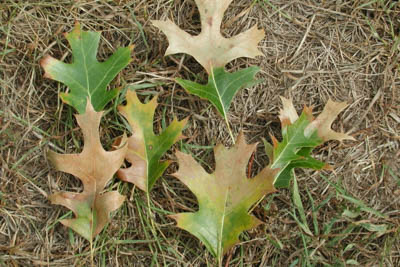
Oak wilt symptoms on oak leaves. |
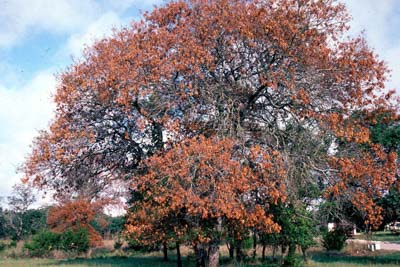
Typical crown symptoms of oak wilt on red oak |
Fungal Mats: In some oak species, particularly in the red oak group, the disease can produce fungal mats beneath the bark. These mats can crack the bark open, emitting a distinctive odor and producing a sticky sap.
Branch Dieback: Starting from the top of the tree, branches begin to die back as the fungus disrupts the water transport system within the tree.
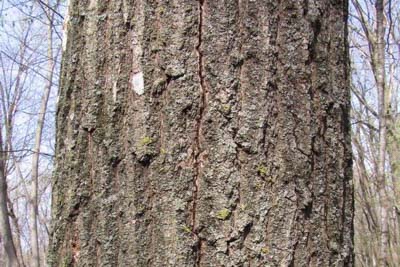
Cracked bark caused by fungal mat of oak wilt disease. |
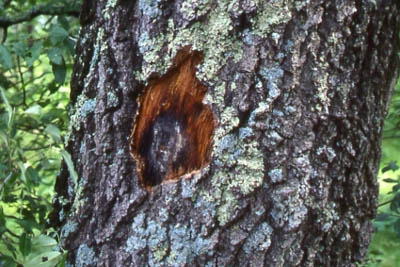
Fungal mat of oak wilt disease. |
Pattern of Spread: In a forest or grove, the spread pattern may be noticeable, with trees dying in a radiating pattern from a central point, indicating underground spread through root grafts.
Discoloration of the Wood: Upon cutting into an infected tree, staining or discoloration of the sapwood can sometimes be observed.
Early detection and diagnosis are key, as these symptoms can sometimes be confused with other tree diseases or environmental stresses.
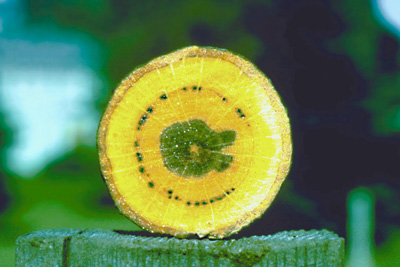
Vascular discoloration in white oak |
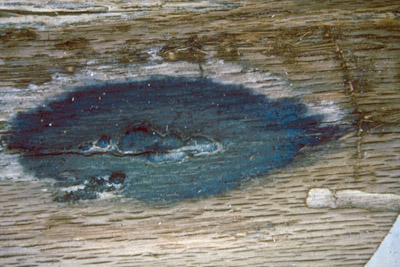
Fungal mat of oak wilt disease. |
The disease cycle involves several key stages:
Infection: The cycle begins when the fungus infects an oak tree. Infection can occur through root grafts between neighboring trees or via wounds on the tree, often created by pruning or storm damage. These wounds can attract sap-feeding beetles carrying fungal spores.
Fungal Growth and Symptom Development: Once inside the tree, the fungus grows in the water-conducting vessels (xylem), producing fungal mats. These mats block water transport, leading to wilting and discoloration of leaves. Symptoms usually appear in late spring or early summer.
Fungal Mat Formation: In certain species, especially in the red oak group, the fungus forms pressure pads or mats under the bark after the tree dies. These mats emit a sweet odor that attracts sap-feeding beetles.
Spore Dispersal: The attracted beetles pick up spores from the fungal mats and can transfer them to healthy trees, infecting fresh wounds. This is most common during warm and moist conditions in spring and early summer.
Spread Through Root Grafts: The fungus can also spread underground from an infected tree to a healthy one through root grafts, a common occurrence in closely planted oak stands.
Tree Death and Cycle Continuation: Infected trees eventually die. The fungus can survive in the dead wood, continuing the cycle if not properly managed. Dead trees can also form fungal mats the following spring, perpetuating the cycle.
Preventing and controlling Oak Wilt requires a combination of proactive measures and prompt responses to infections:
Avoid Pruning During High-Risk Periods: Refrain from pruning oaks from spring to mid-summer (April to July), as wounds can attract beetles that spread the fungus. If emergency pruning is necessary, immediately seal the wounds with a pruning sealer. Sterilize your pruning equipment between trees.
Proper Sanitation: Remove and properly dispose of dead or dying oak trees, especially those with Oak Wilt, to prevent the spread. Burning, burying, or chipping the wood can be effective.
Prevent Root Graft Transmission: In areas with dense oak populations, install root graft barriers by trenching between healthy and infected trees. This physical barrier should be at least 4 feet deep.
Use Fungicides: Professionally applied fungicides, like propiconazole, can protect healthy trees or treat early infections. This is particularly effective for high-value trees or in urban settings.
Promote Tree Health: Maintain the overall health of oaks through proper watering, mulching, and fertilizing as needed. Healthy trees are more resistant to disease.
Vector Control: Control of insect vectors like sap-feeding beetles can be challenging but reducing their breeding sites, like removing dead wood, can help.
Community Awareness and Action: Educate the community about Oak Wilt and the importance of prevention. Coordinated efforts in neighborhoods and communities can be more effective than individual actions.
Regular Monitoring: Regularly inspect oak trees for signs of the disease, especially during the growing season, for early detection and management.
Combining these strategies can effectively prevent and control Oak Wilt, protecting oak populations and the ecosystems they support.
Create a membership account to save your garden designs and to view them on any device.
Becoming a contributing member of Gardenia is easy and can be done in just a few minutes. If you provide us with your name, email address and the payment of a modest $25 annual membership fee, you will become a full member, enabling you to design and save up to 25 of your garden design ideas.
Join now and start creating your dream garden!
Create a membership account to save your garden designs and to view them on any device.
Becoming a contributing member of Gardenia is easy and can be done in just a few minutes. If you provide us with your name, email address and the payment of a modest $25 annual membership fee, you will become a full member, enabling you to design and save up to 25 of your garden design ideas.
Join now and start creating your dream garden!